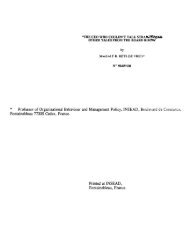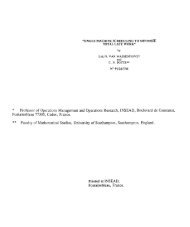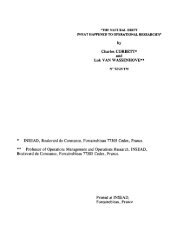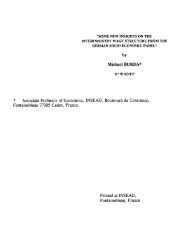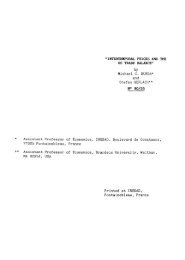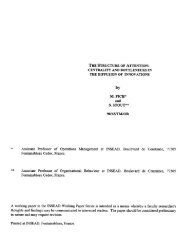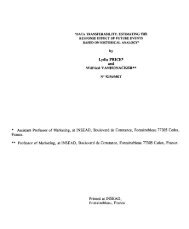* Assistant Professor of Operations Management at INSEAD ...
* Assistant Professor of Operations Management at INSEAD ...
* Assistant Professor of Operations Management at INSEAD ...
Create successful ePaper yourself
Turn your PDF publications into a flip-book with our unique Google optimized e-Paper software.
Proposition 1 Assume th<strong>at</strong> two firms described by 111/1II/1 queues engage in<br />
quantity competition, and th<strong>at</strong> the customer popul<strong>at</strong>ion consists <strong>of</strong> N groups,<br />
indexed by n = N, with delay cost to average service time r<strong>at</strong>ios c„1.1„<br />
decreasing in n. Assume th<strong>at</strong> Vn, Pn(•) are concave decreasing and th<strong>at</strong> each<br />
firm can <strong>of</strong>fer any st<strong>at</strong>ionary scheduling policy.<br />
Then it is optimal for both firms to adopt a st<strong>at</strong>ic priority policy, where<br />
type n customers are assigned higher priority than type (n 1) customers.<br />
If the firms have sufficient capacity, i.e., /I n > P Vn, then there exists<br />
a unique equilibrium th<strong>at</strong> is symmetric, i.e., for all n: Ain = A2n a An. The<br />
firm outputs are characterized by the rel<strong>at</strong>ionships<br />
N<br />
Vn = 1, N : Pn(An) — — E<br />
J.1<br />
ow,<br />
_O.<br />
aAn<br />
(2)<br />
Pro<strong>of</strong>.<br />
The pro<strong>of</strong> is included in the appendix. The reader will notice th<strong>at</strong> the pro<strong>of</strong><br />
holds for the more general case <strong>of</strong> the firms being MIGIl queues; the formul<strong>at</strong>ion<br />
<strong>of</strong> the proposition is restricted to the 1111.111.11 case only to be consistent<br />
with the assumptions <strong>of</strong> Proposition 2.<br />
Proposition 1 st<strong>at</strong>es th<strong>at</strong> as long as the capabilities <strong>of</strong> the firms are the<br />
same, not even asymmetries in the imp<strong>at</strong>ience <strong>of</strong> the customer popul<strong>at</strong>ion<br />
make asymmetric equilibria on the firm side possible. Firms will not differenti<strong>at</strong>e<br />
into different niches, but all approach the market in the same manner.<br />
If the firms' capabilities (the service r<strong>at</strong>es) differ, then have consistently<br />
found in numerical examples th<strong>at</strong> a firm th<strong>at</strong> is superior in all segments will<br />
also capture a higher share and charge a higher price in all segments. Only<br />
if a firm has a unique capability in one segment (modeled by a specific pin),<br />
one will observe a specific niche str<strong>at</strong>egy exhibited by one firm. Although<br />
we have not proven these results in general, the findings suggest th<strong>at</strong> time<br />
differenti<strong>at</strong>ion has to be backed up by firm capabilities even in the case <strong>of</strong><br />
customer groups with differing imp<strong>at</strong>ience (see Loch (1994) for a discussion<br />
<strong>of</strong> the homogeneous customer case).<br />
Wh<strong>at</strong> are the welfare implic<strong>at</strong>ions <strong>of</strong> the equilibrium described? Consider<br />
a social planner who wants to maximize the total welfare in an industry<br />
with N customer groups and two non-pooled production facilities. Observe<br />
th<strong>at</strong> customer group n receives utility fzAfo Pn (x)dx from an order stream <strong>of</strong><br />
9



